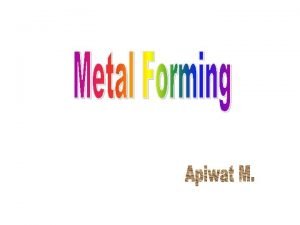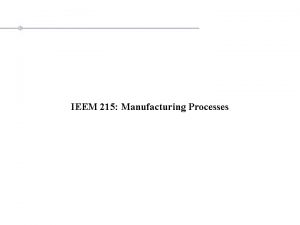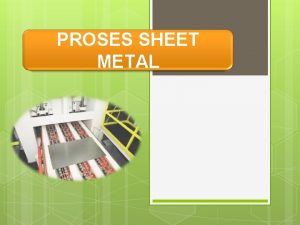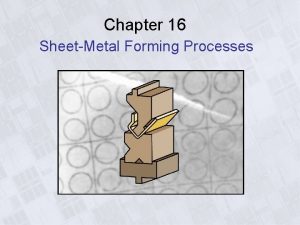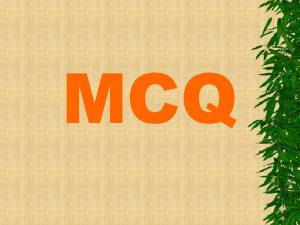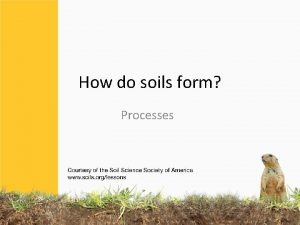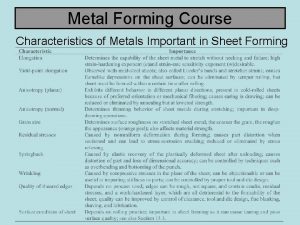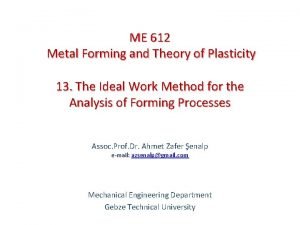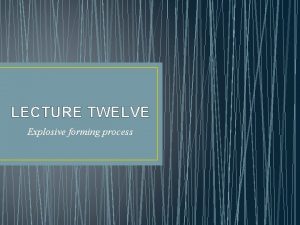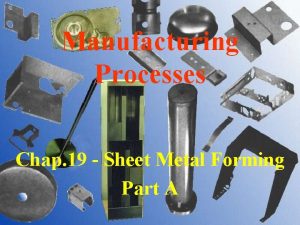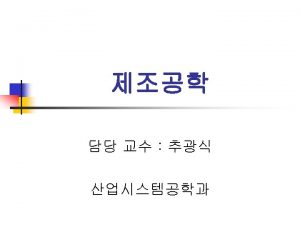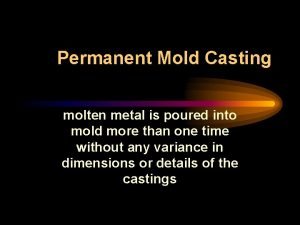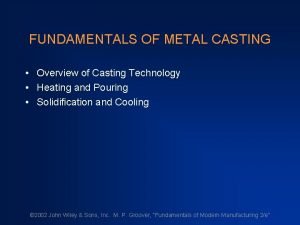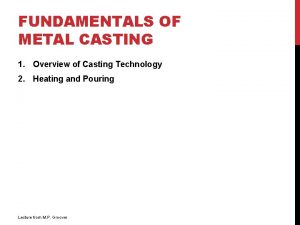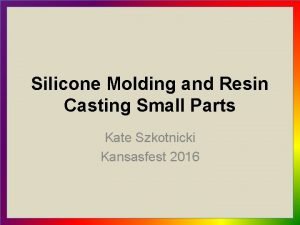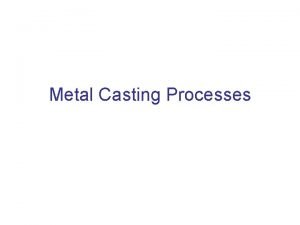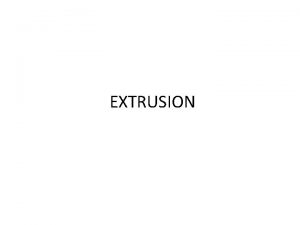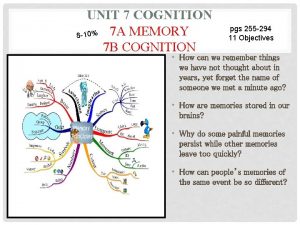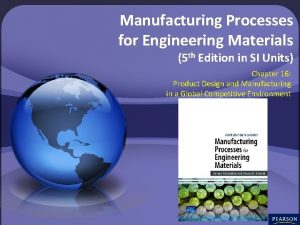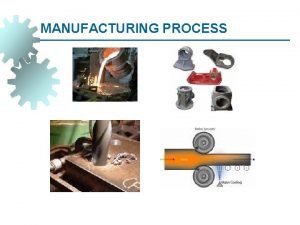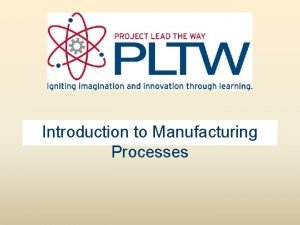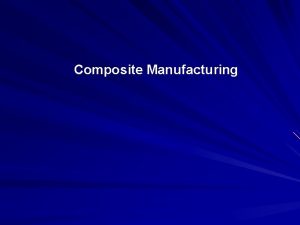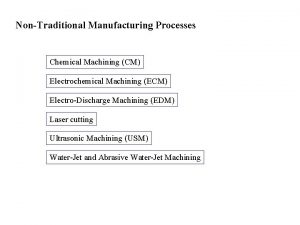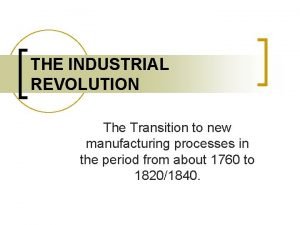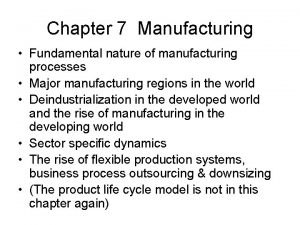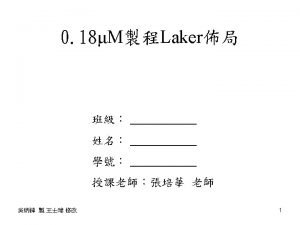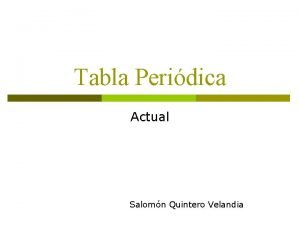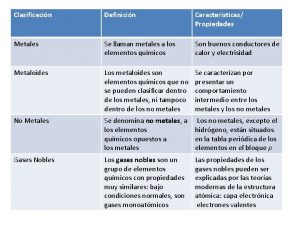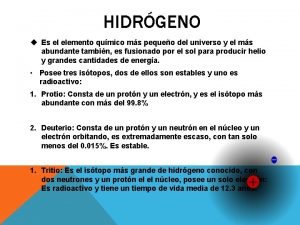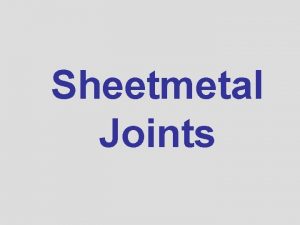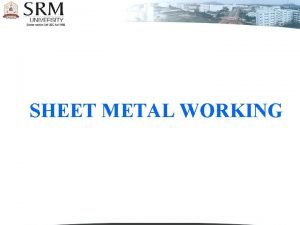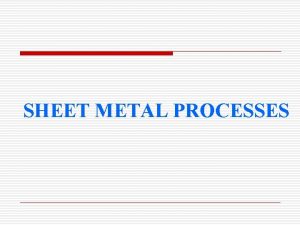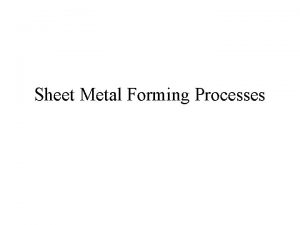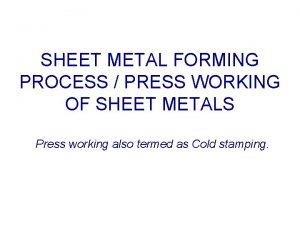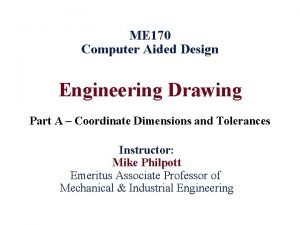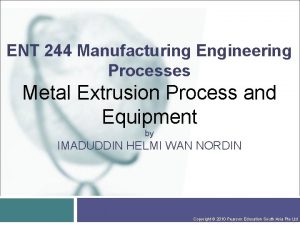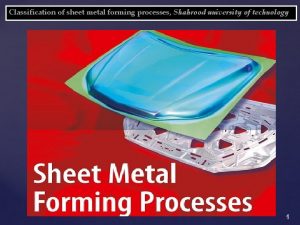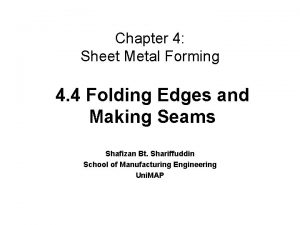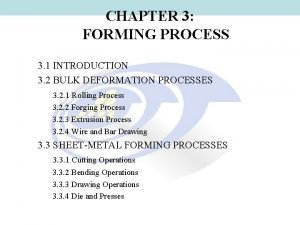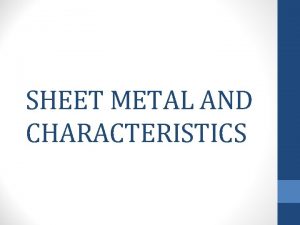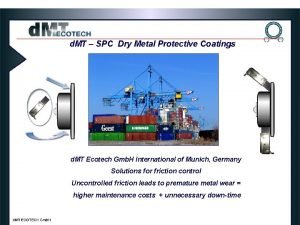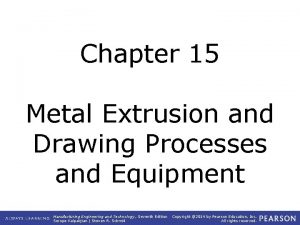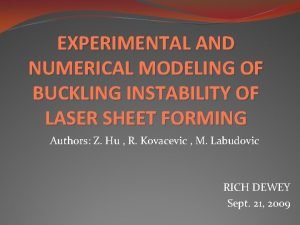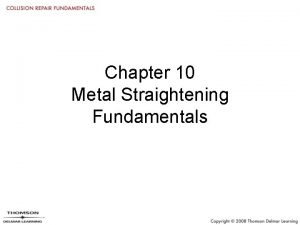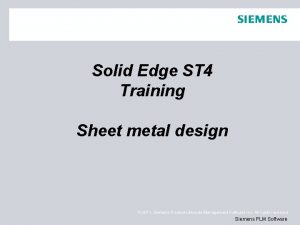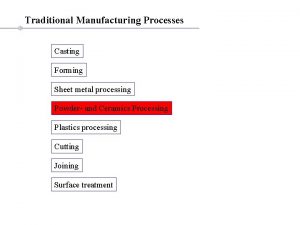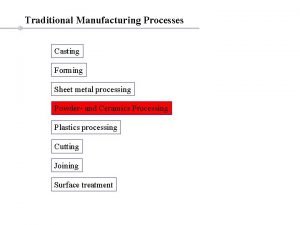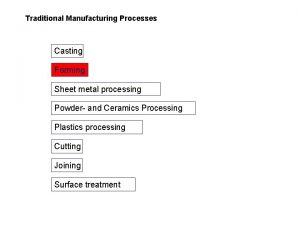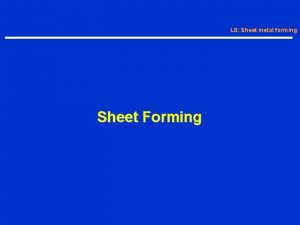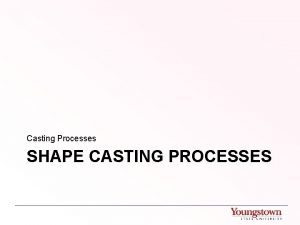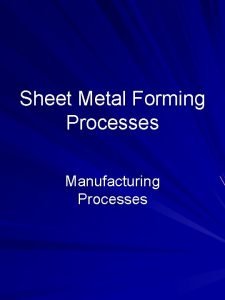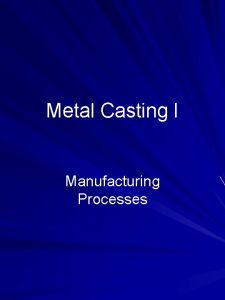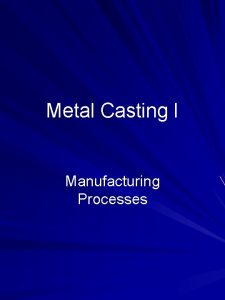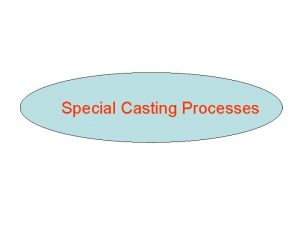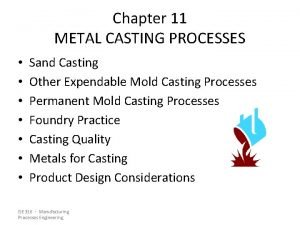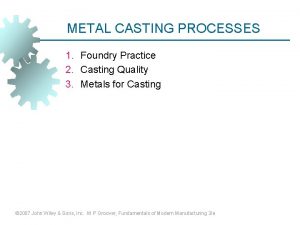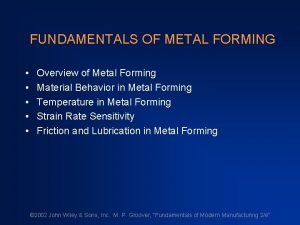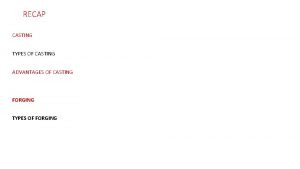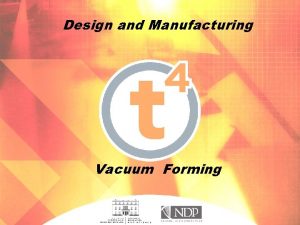Traditional Manufacturing Processes Casting Forming Sheet metal processing






























![Analysis: process parameters optimization Model objective: Find optimum feed, cutting speed to [maximize MRR]/[minimize Analysis: process parameters optimization Model objective: Find optimum feed, cutting speed to [maximize MRR]/[minimize](https://slidetodoc.com/presentation_image_h2/5792f6a6fa373257c84a05346fa861fb/image-31.jpg)























![Mechanical hardening Shot peening precision auto gears [source: www. vacu-blast. co. uk] Laser peening Mechanical hardening Shot peening precision auto gears [source: www. vacu-blast. co. uk] Laser peening](https://slidetodoc.com/presentation_image_h2/5792f6a6fa373257c84a05346fa861fb/image-55.jpg)







- Slides: 62

Traditional Manufacturing Processes Casting Forming Sheet metal processing Powder- and Ceramics Processing Plastics processing Cutting Joining Surface treatment

Cutting Processes that involve removal of material from solid workpiece Sawing Shaping (or planing), Broaching, drilling, Grinding, Turning Milling Important concept: PROCESS PLANNING Fixturing and Location Operations sequencing Setup planning Operations planning

Sawing A process to cut components, stock, etc. Process character: Precision: [very low, , very high]; MRR: low

Sawing

Shaping A process to plane the surface of a workpiece (or to reduce part thickness Process character: High MRR, medium Surface finish, dimension control

Broaching Precise process for mass-production of complex geometry parts (complicated hole-shapes) Process character: High MRR, Very good surface, dimension control, Expensive

Drilling, Reaming, Boring Processes to make holes Process character: High MRR, Cheap, Medium-high surface, dimension control

Drilling basics - softer materials small point angle; hard, brittle material: larger point angle - Length/Diameter ratio is large gun-drilling (L/D ratio ~ 300) - Very small diameter holes (e. g. < 0. 5 mm): can’t drill (why? ) - F drilled hole > F drill: vibrations, misalignments, … - Tight dimension control: drill ream - Spade drills: large, deep holes - Coutersink/counterbore drills: multiple diameter hole screws/bolts heads

Tapping Processes to make threads in holes Process character: low MRR, Cheap, good surface, dimension control Manual tap and die set Automated tapping

Grinding, Abrasive Machining Processes to finish and smooth surfaces Process character: very low MRR, very high surface, dimension control 1. To improve the surface finish of a manufactured part (a) Injection molding die: milling manual grinding/electro-grinding. (b) Cylinders of engine: turning grinding honing lapping 2. To improve the dimensional tolerance of a manufactured part (a) ball-bearings: forging grinding [control: < 15 mm] (b) Knives: forged steel hardened grinding 3. To cut hard brittle materials (a) Semiconductor IC chips: slicing and dicing 4. To remove unwanted materials of a cutting process (a) Deburring parts made by drilling, milling

Abrasive tools and Machines

Turning Processes to cut cylindrical stock into revolved shapes Process character: high MRR, high surface, dimension control

Turning operations

Fixturing parts for turning

Milling Versatile process to cut arbitrary 3 D shapes Process character: high MRR, high surface, dimension control [source: Kalpakjian & Schmid]]

Common vertical milling cutters Flat Ballnose Bullnose

Up and Down milling

Fixtures for Milling: Vise

Fixtures for Milling: Clamps

Process Analysis Fundamental understanding of the process improve, control, optimize Method: Observation modeling verification Every process must be analyzed; [we only look at orthogonal 1 -pt cutting]

Geometry of the cutting tool

Modeling: Mechanism of cutting Old model: crack propagation Current model: shear

Tool wear: observations and models High stresses, High friction, High temp (1000 C) tool damage Adhesion wear: fragments of the workpiece get welded to the tool surface at high temperatures; eventually, they break off, tearing small parts of the tool with them. Abrasion: hard particles, microscopic variations on the bottom surface of the chips rub against the tool surface Diffusion wear: at high temperatures, atoms from tool diffuse across to the chip; the rate of diffusion increases exponentially with temperature; this reduces the fracture strength of the crystals.

Tool wear, Tool failure, Tool life criteria 1. Catastrophic failure (e. g. tool is broken completely) 2. VB = 0. 3 mm (uniform wear in Zone B), or VBmax = 0. 6 mm (non-uniform flank wear) 3. KT = 0. 06 + 0. 3 f, (where f = feed in mm/revolution).

Built-up edge (BUE) Deposition, work hardening of a thin layer of the workpiece material on the surface of the tool. BUE poor surface finish Likelihood of BUE decreases with (i) decrease in depth of cut, (ii) increase in rake angle, (iii) use of proper cutting fluid during machining.

Process modeling: empirical results Experimental chart showing relation of tool wear with f and V [source: Boothroyd]

Modeling: surface finish Relation of feed and surface finish

Analysis: Machining Economics How can we optimize the machining of a part ? Identify the objective, formulate a model, solve for optimality Typical objectives: maximum production rate, and/or minimum cost Are these objectives compatible (satisfied simultaneously) ? Formulating model: observations hypothesis theory model

Analysis: Machining Economics. . Formulating model: observations hypothesis theory model Observation: A given machine, tool, workpiece combination has finite max MRR Hypothesis: Total volume to cut is minimum Maximum production rate Model objective: Find minimum volume stock for a given part -- Near-net shape stocks (use casting, forging, …) -- Minimum enclosing volumes of 3 D shapes Models: - minimum enclosing cylinder for a rotational part - minimum enclosing rectangular box for a milled part Solving: -- requires some knowledge of computational geometry

Analysis: Machining Economics. . Model objective: Find optimum operations plan and tools for a given part Example: or or ? ? Model: Process Planning - Machining volume, tool selection, operations sequencing Solving: - in general, difficult to optimize
![Analysis process parameters optimization Model objective Find optimum feed cutting speed to maximize MRRminimize Analysis: process parameters optimization Model objective: Find optimum feed, cutting speed to [maximize MRR]/[minimize](https://slidetodoc.com/presentation_image_h2/5792f6a6fa373257c84a05346fa861fb/image-31.jpg)
Analysis: process parameters optimization Model objective: Find optimum feed, cutting speed to [maximize MRR]/[minimize cost]/… Feed: Higher feed higher MRR Finish cutting: surface finish feed Given surface finish, we can find maximum allowed feed rate

Process parameters optimization: feed Rough cutting: MRR cutting speed, V MRR feed, f cannot increase V and f arbitrarily ↑ V ↑ MRR; surface finish ≠ f(V); energy per unit volume MRR ≠ f(V) Tool temperature V, f; Friction wear V; Friction wear ≠ f For a given increase in MRR: ↑ V lower tool life than ↑ f Optimum feed: maximum allowed for tool [given machine power, tool strength]

Process parameters optimization: Speed Model objective: Given optimum feed, what is the optimum cutting speed provided upper limits, but not optimum Need a relation between tool life and cutting speed (other parameters being constant) Taylor’s model (empirically based): V tn = constant

Process parameters optimization: Speed One batch of large number, Nb, of identical parts Replace tool by a new one whenever it is worn Total non-productive time = Nbtl tl = time to (load the stock + position the tool + unload the part) Nb be the total number of parts in the batch. Total machining time = Nbtm tm = time to machine the part Total tool change time = Nttc tc = time to replace the worn tool with a new one Nt = total number tools used to machine the entire batch. Cost of each tool = Ct, Cost per unit time for machine and operator = M. Average cost per item:

Process parameters optimization: Speed Average cost per item: Let: total length of the tool path = L t = tool life Taylor’s model Nt = (Nb tm)/t Vtn = C’ Nt / N b = t m / t t = C’ 1/n / V 1/n = C/V 1/n

Process parameters optimization: Speed Average cost per item:

Process parameters optimization: Speed Optimum speed (to minimize costs) Optimum speed (to minimize time) Average time to produce part:

Process parameters optimization: Speed Optimum speed (to minimize costs) Optimum speed (to minimize time) Average time to produce part: load/unload time machining time tool change time Substitute, differentiate, solve for V*

Process Planning The process plan specifies: operations tools, path plan and operation conditions setups sequences possible machine routings fixtures

Process Planning

Operation sequencing examples (Milling) step hole or hole step big-hole step small hole or small hole step big-hole or …

Traditional Manufacturing Processes Casting Forming Sheet metal processing Powder- and Ceramics Processing Plastics processing Cutting Joining Surface treatment

Joining Processes Types of Joints: 1. Joints that allow relative motion (kinematic joints) 2. Joints that disallow any relative motion (rigid joints) Uses of Joints: 1. To restrict some degrees of freedom of motion 2. If complex part shape is impossible/expensive to manufacture 3. To allow assembled product be disassembled for maintenance. 4. Transporting a disassembled product is sometimes easier/feasible

Joining Processes Fusion welding: joining metals by melting solidification Solid state welding: joining metals without melting Brazing: joining metals with a lower mp metal Soldering: joining metals with solder (very low mp) Gluing: joining with glue Mechanical joining: screws, rivets etc.

Fusion welding Flame: 3000 C Oxy-acetylene welding Arc welding robotic manual arc: 30, 000 C Gas shielded arc welding MIG TIG Argon Al Ti, Mg, Thin sections

Fusion welding. . Deep, narrow welds Aerospace, medical, automobile body panels Plasma arc welding Faster than TIW, slower than Laser Nd: YAG and CO 2 lasers, power ~ 100 k. W Laser beam welding Fast, high quality, deep, narrow welds, expensive Electron beam welding

Solid state welding Diffusion welds between very clean, smooth pieces of metal, at 0. 3~0. 5 Tm Cold welding (roll bonding) coins, bimetal strips

Solid state welding. . Ultrasonic welding Ultrasonic wire bonder 25 mm Al wire on IC Chip Medical, Packaging, IC chips, Toys Materials: metal, plastic - clean, fast, cheap

Resistance welding Welding metal strips: clamp together, heat by current Spot welding Seam welding

Brazing Tm of Filler material < Tm of the metals being joined Torch brazing Common Filler materials: copper-alloys, e. g. bronze Common applications: pipe joint seals, ship-construction Soldering Tin + Lead alloy, very low Tm (~ 200 C) Main application: electronic circuits Furnace brazing

Gluing

Mechanical fasteners (a) Screws (b) Bolts, nuts and washers (a) pneumatic carton stapler (b) Clips (c) Rivets (c) A circlip in the gear drive of a kitchen mixer Plastic wire clips Plastic snap-fasteners Wire conductor: crimping

Traditional Manufacturing Processes Casting Forming Sheet metal processing Powder- and Ceramics Processing Plastics processing Cutting Joining Surface treatment

Surface treatment, Coating, Painting Post-production processes Only affect the surface, not the bulk of the material 1. Improving the hardness 2. Improving the wear resistance 3. Controlling friction, Reduction of adhesion, improving the lubrication, etc. 4. Improving corrosion resistance 5. Improving aesthetics
![Mechanical hardening Shot peening precision auto gears source www vacublast co uk Laser peening Mechanical hardening Shot peening precision auto gears [source: www. vacu-blast. co. uk] Laser peening](https://slidetodoc.com/presentation_image_h2/5792f6a6fa373257c84a05346fa861fb/image-55.jpg)
Mechanical hardening Shot peening precision auto gears [source: www. vacu-blast. co. uk] Laser peening [source: www. uwinint. co. kr]

Case hardening Process Dopant Procedure Notes Applications Carburizing C Low-carbon steel part in oven at 870 -950 C with excess CO 2 0. 5 ~ 1. 5 mm case gets to 65 HRC; poor dimension control Gears, cams, shafts, bearings Carbo. Nitriding C and N Low-carbon steel part in oven at 800 -900 C with excess CO 2 and NH 3 0. 07~0. 5 mm case, up to 62 HRC, lower distortion Nuts, gears Cyaniding C and N Low-carbon steel part in bath of cyanide salts with 30% Na. CN 0. 025~0. 25 mm case, up to 65 HRC nuts, bolts, gears, screws Nitriding N Low-carbon steel part in oven at 500 -600 C with excess NH 3 0. 1~0. 6 mm case, up to 1100 HV tools, shafts Boronizing B Part heated in oven with Boron containing gas Very hard, wear resistant case, 0. 025~0. 075 mm Tool and die steels bolts, gears,

Vapor deposition Deposition of thin film (1~10 mm) of metal Sputtering: important process in IC Chip manufacture

Thermal spraying High velocity oxy-fuel spraying Thermal metal powder spray Tungsten Carbide / Cobalt Chromium Coating on roll for Paper Manufacturing Industry Plasma spray [source: www. fst. nl/process. htm]

Electroplating Deposit metal on cathode, sacrifice from anode chrome-plated auto parts copper-plating Anodizing Metal part on anode: oxide+coloring-dye deposited using electrolytic process

Painting Type of paints: Enamel: oil-based; smooth, glossy surface Lacquers: resin based; dry as solvent evaporates out; e. g. wood varnish Water-based paints: e. g. wall paints, home-interior paints Painting methods Dip coating: part is dipped into a container of paint, and pulled out. Spray coating: most common industrial painting method Electrostatic spraying: charged paint particles sprayed to part using voltage Silk-screening: very important method in IC electronics mfg

Painting Electrostatic Spray Painting in BMW plant Silk screening

Summary These notes covered processes: cutting, joining and surface treatment We studied one method of modeling a process, in order to optimize it We introduced the importance and difficulties of process planning. Further reading: Chapters 24, 21, 30 -32: Kalpajian & Schmid
 Bulk deformation processes
Bulk deformation processes Similar
Similar Proses forming
Proses forming Forming process in sheet metal
Forming process in sheet metal Mcq on sheet metal forming
Mcq on sheet metal forming 4 soil forming processes
4 soil forming processes Hot hot
Hot hot Draw bead
Draw bead Metal forming analysis gtu
Metal forming analysis gtu Advantages of explosive forming
Advantages of explosive forming Metal forming part factories
Metal forming part factories Metal forming
Metal forming Graphite permanent mold casting
Graphite permanent mold casting Chvorinov's rule for riser design
Chvorinov's rule for riser design Fundamentals of metal casting
Fundamentals of metal casting Resin casting small metal parts
Resin casting small metal parts Solid answer
Solid answer Pvc air blowing mould
Pvc air blowing mould What effortful processing methods aid in forming memories?
What effortful processing methods aid in forming memories? Manufacturing cost vs non manufacturing cost
Manufacturing cost vs non manufacturing cost Process costing vs job costing
Process costing vs job costing Cost concept and classification
Cost concept and classification Manufacturing cost vs non manufacturing cost
Manufacturing cost vs non manufacturing cost Additively
Additively Manufacturing processes for engineering materials 5th
Manufacturing processes for engineering materials 5th Classification of production system
Classification of production system List of manufacturing processes
List of manufacturing processes Pultrusion process
Pultrusion process Nontraditional manufacturing processes
Nontraditional manufacturing processes The transition to new manufacturing processes
The transition to new manufacturing processes Nature of manufacturing process
Nature of manufacturing process Concurrent processes are processes that
Concurrent processes are processes that Solid particles diagram
Solid particles diagram Metal and non metal
Metal and non metal Acidity trends periodic table
Acidity trends periodic table Diamond melting point
Diamond melting point Nwell
Nwell Use of non metals
Use of non metals Is sulfer a metal nonmetal or metalloid
Is sulfer a metal nonmetal or metalloid Metals react with nonmetals to form ionic compounds by
Metals react with nonmetals to form ionic compounds by Periodo y grupo
Periodo y grupo Chemical bond def
Chemical bond def Caracteristicas del carbono
Caracteristicas del carbono Is sodium more reactive than potassium
Is sodium more reactive than potassium Electrones de valencia de francio
Electrones de valencia de francio Grooved joint in sheet metal
Grooved joint in sheet metal Sheet metal workshop introduction
Sheet metal workshop introduction Superplastic forming
Superplastic forming Sheet metal characteristics
Sheet metal characteristics Progressive dies
Progressive dies Parallel line pattern development
Parallel line pattern development Engineering drawing symbols
Engineering drawing symbols Plastic extrusion defects
Plastic extrusion defects Classification of sheet metal
Classification of sheet metal Locked seam joint
Locked seam joint Bending operation in sheet metal
Bending operation in sheet metal Sheet metal characteristics
Sheet metal characteristics Pneumatic sheet metal cutting machine
Pneumatic sheet metal cutting machine Spc sheet metal
Spc sheet metal Sheet metal extrusion process
Sheet metal extrusion process Sheet metal buckling
Sheet metal buckling How to straighten bent sheet metal
How to straighten bent sheet metal Sheet metal gusset design
Sheet metal gusset design
